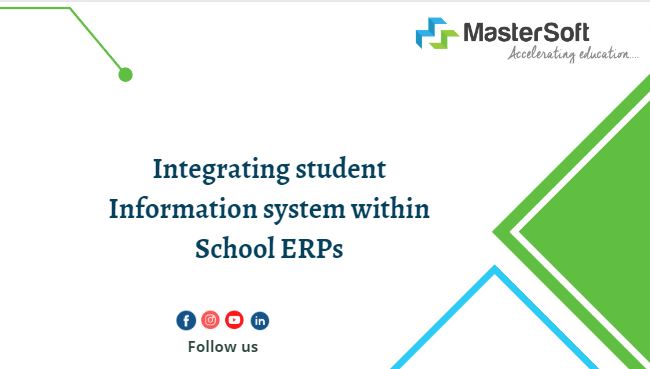
Integrating student Information system within School ERPs
In the world of contemporary education, the efficient handling of administrative duties and the accurate monitoring of student data are crucial in determining the nature of the learning process. Technology has dramatically changed how schools are run, and two key elements stand out: the Student Information System (SIS) and the School ERP (Enterprise Resource Planning) system. When combined, these platforms create a powerful team that has the power to completely alter the way that education is delivered. An in-depth discussion of the importance of SIS integration inside school ERPs and how it improves learning outcomes for both students and educational institutions is provided in this blog.
Maximizing Learning Potential: Integrating SIS Within School ERPs
-
Learning About School SIS And ERP
Within educational institutions, a School ERP system functions as a complete platform that simplifies several administrative and operational activities. A school ERP effectively manages a wide range of tasks, from attendance monitoring to fee administration, from timetable scheduling to parent communication. A Student Information System (SIS), on the other hand, is concentrated on handling and arranging specific student data. This includes academic history, attendance data, exam results, and private data. When these two systems come together, a comprehensive solution emerges that not only streamlines administrative procedures but also improves students’ educational experiences.
-
Improved Data Accessibility And Accuracy
Data duplication and discrepancies are eliminated when SIS is integrated with a school ERP. The ERP system instantly synchronizes with the SIS as student data is input, ensuring that all departments have access to the most recent and correct data. The likelihood of mistakes, which frequently happen when entering data manually, is reduced by this integration. Additionally, seamless access to pertinent student data is available to educators, administrators, and parents, promoting thoughtful decision-making and efficient communication.
-
Effective Management Of Attendance
An important part of managing a school is keeping track of attendance. The attendance management process is automated when SIS is integrated into a school ERP. The ERP system updates in real-time with changes to the SIS’s attendance records for students. With this connection, less human labor is needed to handle attendance, and accurate attendance records are guaranteed. Transparency and accountability are promoted by the ease with which teachers can record attendance and the ease with which parents can check on their children’s attendance via the parent portal.
-
Tracking Academic Progress More Efficiently
A School ERP that integrates SIS gives teachers a thorough understanding of their kids’ academic development. The SIS, which smoothly interfaces with the ERP system, allows teachers to submit test results, assignment marks, and assessments. Through this integration, teachers are better equipped to follow each student’s academic progress, pinpoint their strengths and areas for development, and offer personalized help. These records are accessible to parents and students as well, encouraging teamwork in education.
-
Experience Personalized Learning
Every kid is different, with different requirements and learning preferences. By integrating SIS into a school ERP, instructors may customize the learning environment for every student. Teachers may design individualized learning paths by gaining access to the academic histories, preferences, and performance information of their students. Lessons are tailored to each student’s strengths and difficulties, which encourages student participation and enhances learning results.
-
Effective Communication Methods
Building a successful connection between the family and the school requires effective communication. A school ERP that integrates SIS provides reliable communication channels. Through the technology, teachers may immediately distribute announcements, assignments, and updates. In order to keep everyone informed on the progress and activities of the pupils, parents and instructors may communicate. The educational community is strengthened by this integration, which increases openness and closes gaps in communication.
-
Simplified Fee Administration
Fee management is a difficult procedure that needs precision and effectiveness. Fee tracking and collection are made easier with SIS integration in a school ERP. Data pertaining to fees is input into the SIS and automatically reflected in the ERP system. Due to this connection, parents may view and pay fees online, which reduces administrative labor and encourages a quick and easy cashless fee payment system.
-
Resource Allocation That Is Optimized
Resource allocation issues plague educational institutions frequently. A school ERP that integrates SIS offers useful insights into student demographics, performance patterns, and resource usage. This information may be used by schools to better prepare lesson plans, allocate resources, and decide whether to improve the curriculum.
-
Making Decisions Based On Data
Decision-making in educational institutions is becoming more and more data-driven. By integrating student Information systems into a school ERP, access to extensive data sets that may guide strategic decisions is made possible. Data-driven insights help administrators and educators improve the whole learning process by identifying areas for academic growth and assessing instructional methods.
Conclusion
The integration of SIS inside School ERPs has emerged as a game-changer in an educational environment that is continually changing. This convergence not only makes administrative activities more efficient, but it also ushers in a new era of efficacy and efficiency in education. Among the many advantages this connection offers are improved data accuracy, attendance management, academic progress monitoring, individualized learning experiences, communication channels, fee management, resource efficiency, and data-driven decision-making. Educational institutions may create a setting where kids flourish, teachers succeed, and the entire learning community prospers by utilizing the potential of both School ERP and student Information system.



